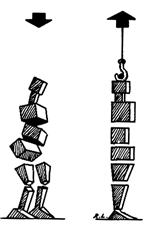(excerpt from Rolfing® Structural Integration by Jason Mixter, Certified Advanced Rolfer™)
 Dr. Rolf’s view of the role of the fascia in posture led to still another major discovery. It might be called the theory of body geometry.
Dr. Rolf’s view of the role of the fascia in posture led to still another major discovery. It might be called the theory of body geometry.
When an elbow, knee or any other joint is properly balanced, the individual experiences an internal sense of rightness. The body senses that it is aligned along the true planes of movement. The hinges of the legs (hips, knees, ankles, even toes) all work within a single plane. The paths of the legs have parallel courses. The head and spine feel a clear sense of “up.” The elbows move naturally through their angle in a smooth course. Compared with this new organization, the previous functioning of the body appears random, even chaotic. In contrast, the new geometry, this new orientation in space, feels much more secure. The goal of the Rolfer is to bring the body close to its center line of gravity so that fewer muscles are required for basic standing and sitting. “Posture” is no longer an immobile holding action but a floating balance and ease. It is this attention to the proper body geometry that distinguishes Rolfing from those forms of body work that simply seek deep tissue massage and relaxation.
 Naturally, each person has his or her own version of this ideal geometry, which depends on the person’s height, the length of his or her limbs, and other similar factors. But Rolfers consider live basic points when planning individual goals for a client. In order for the human body to function properly and maintain an upright position, these five landmarks must be in alignment: the ear, the shoulder, the hip, the knee and the ankle. The head, neck and shoulders tell the story of the structure below them. The body should glide along, rather than look as if it has to do extremely hard work with every step. The head and neck must be centered over the middle of the body, and the spine that supports the structure must be at the back of the pelvic section. The spine must then curve in conjunction with the natural back curvature until it enters the base of the skull in a central direction. Any damage or constant pressure will disturb the balance of the upper torso.
Naturally, each person has his or her own version of this ideal geometry, which depends on the person’s height, the length of his or her limbs, and other similar factors. But Rolfers consider live basic points when planning individual goals for a client. In order for the human body to function properly and maintain an upright position, these five landmarks must be in alignment: the ear, the shoulder, the hip, the knee and the ankle. The head, neck and shoulders tell the story of the structure below them. The body should glide along, rather than look as if it has to do extremely hard work with every step. The head and neck must be centered over the middle of the body, and the spine that supports the structure must be at the back of the pelvic section. The spine must then curve in conjunction with the natural back curvature until it enters the base of the skull in a central direction. Any damage or constant pressure will disturb the balance of the upper torso.
In quite a few words, that’s Rolfing, but the definition may make no sense to you because you’ve never seen or felt Rolfing. To remedy that, let’s follow a client through her first session and then get into a little routine that will give you a few of the feelings that a Rolfing client has in that initial encounter.
Rolfing® and Rolfer™ are service marks of the Rolf Institute® of Structural Integration